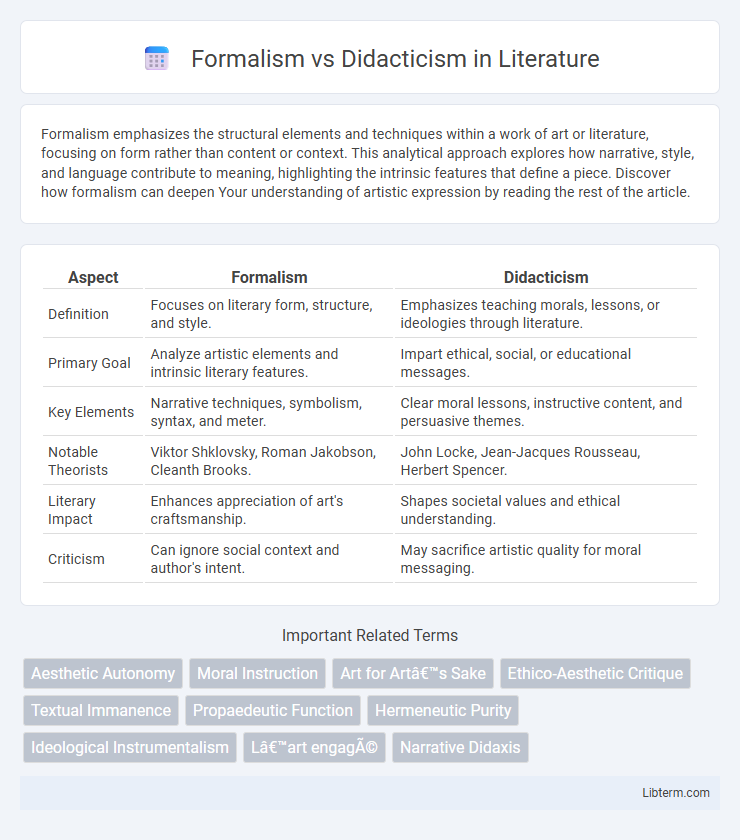Formalism emphasizes the structural elements and techniques within a work of art or literature, focusing on form rather than content or context. This analytical approach explores how narrative, style, and language contribute to meaning, highlighting the intrinsic features that define a piece. Discover how formalism can deepen Your understanding of artistic expression by reading the rest of the article.
Table of Comparison
| Aspect | Formalism | Didacticism |
|---|---|---|
| Definition | Focuses on literary form, structure, and style. | Emphasizes teaching morals, lessons, or ideologies through literature. |
| Primary Goal | Analyze artistic elements and intrinsic literary features. | Impart ethical, social, or educational messages. |
| Key Elements | Narrative techniques, symbolism, syntax, and meter. | Clear moral lessons, instructive content, and persuasive themes. |
| Notable Theorists | Viktor Shklovsky, Roman Jakobson, Cleanth Brooks. | John Locke, Jean-Jacques Rousseau, Herbert Spencer. |
| Literary Impact | Enhances appreciation of art's craftsmanship. | Shapes societal values and ethical understanding. |
| Criticism | Can ignore social context and author's intent. | May sacrifice artistic quality for moral messaging. |
Understanding Formalism in Literature
Formalism in literature emphasizes the intrinsic features of a text, such as structure, language, and literary devices, to derive meaning without relying on external contexts like author intent or historical background. By analyzing elements like symbolism, narrative techniques, and rhyme schemes, Formalism seeks to uncover the work's inherent aesthetic and thematic coherence. This approach fosters a deeper appreciation of the text's form and craftsmanship, distinguishing it from Didacticism, which prioritizes moral or instructive content.
Defining Didacticism: Purpose and Approach
Didacticism prioritizes teaching and moral instruction, emphasizing the communication of clear lessons or ethical messages through literature and art. Its approach is centered on guiding audiences toward specific values or knowledge, often using straightforward narratives and explicit content. Unlike Formalism, which focuses on aesthetic form and structure, Didacticism serves a purposeful role in educating or persuading readers.
Historical Roots of Formalism
Formalism emerged in the early 20th century primarily through the Russian Formalists who emphasized close reading and the autonomous nature of literary form, distancing literature from historical and moral contexts. This movement sought to analyze the intrinsic features of texts, such as structure, language, and literary devices, as opposed to didacticism's focus on moral or educational content. Formalism's historical roots lie in a reaction against the prevailing didactic approaches of the 19th century, responding to the need for a scientific method in literary criticism.
The Evolution of Didactic Literature
Didactic literature evolved from rigid moral instruction to more engaging, narrative-driven forms that balance entertainment with teaching, reflecting shifts in cultural and educational paradigms. This transformation highlights didacticism's move away from overt preaching towards subtle ethical guidance embedded within complex characters and plots. The evolution underscores the genre's adaptability in addressing changing societal values and reader expectations.
Formalism: Art for Art’s Sake
Formalism emphasizes the intrinsic aesthetic qualities of art, focusing on form, composition, color, and technique rather than moral or social messages. Rooted in the principle of "Art for Art's Sake," Formalism values art as an autonomous entity, independent of utilitarian or didactic functions. This approach prioritizes sensory experience and formal elements, arguing that the meaning of a work resides in its artistic execution rather than external content or instruction.
Didacticism: Literature with a Message
Didacticism in literature emphasizes imparting moral, ethical, or educational messages, aiming to instruct readers through narrative content. This approach often prioritizes clear themes and purpose-driven storytelling over stylistic experimentation or formal structure. Works rooted in didacticism serve as tools for social commentary, ethical reflection, or practical guidance, shaping readers' values and perspectives.
Major Proponents and Movements
Formalism, championed by theorists such as Roman Jakobson and Viktor Shklovsky, emphasizes the intrinsic features of literary form and technique, notably within the Russian Formalist movement. Didacticism, associated with classical philosophers like Aristotle and later proponents such as John Locke, prioritizes literature's role in moral and educational instruction, prominently influencing movements including Neoclassicism and Victorian literature. These contrasting approaches reflect ongoing debates about whether literature's primary function lies in artistic expression or moral teaching.
Comparative Analysis: Structure vs. Substance
Formalism emphasizes the analysis of literary structure, focusing on elements such as syntax, meter, and narrative techniques to derive meaning. Didacticism prioritizes content and moral lessons, valuing substance over form to instruct or convey ethical messages. The comparative analysis reveals that formalism scrutinizes how form shapes interpretation, whereas didacticism centers on the practical purpose and educational value of the text's message.
Modern Perspectives on Formalism and Didacticism
Modern perspectives on Formalism emphasize the intrinsic value of artistic elements such as structure, form, and color, arguing that meaning arises primarily from the work itself rather than external context. Didacticism remains focused on art's instructional and moral functions, yet contemporary scholars critique its potential to limit interpretive freedom by prioritizing explicit messages over aesthetic experience. Current debates highlight a balance, suggesting that formal qualities and educational content can coexist to enrich both artistic appreciation and social impact.
The Ongoing Debate: Art, Ethics, and Audience
The ongoing debate between formalism and didacticism centers on whether art should prioritize aesthetic form or ethical content, raising questions about the artist's responsibility to their audience. Formalism emphasizes the intrinsic value of artistic elements such as structure, color, and technique, advocating for an autonomous experience detached from moral messaging. Didacticism, in contrast, asserts that art serves a social or educational purpose, compelling creators to engage with ethical issues and influence audience perception.
Formalism Infographic

 libterm.com
libterm.com